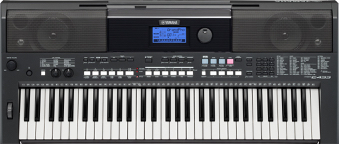"Have you heard of Duran Duran?" asked Bob with some doubt in his voice. (I’ve changed his name to protect the innocent. And to protect me.)
I think he was expecting me to say “Duran who?” but obviously I’ve heard of them. Surely people who haven’t heard of them could be counted on the fingers of one foot.
"Er, yes. Haven't you?"
"Well, yes" he said but didn’t sound sure.
Bob is a colleague of mine at work. He’s younger than me and was brought up by nuns in a convent in Ireland. At least this is what I assume since he seems unclear about the existence of a major 80's pop group. As it happens my missus was a bit of a Duran fan back in the day and fancied one of the band. The ugly one as far as I can tell. I don't know what says about me.
"Why do you ask?"
"Well..." starts Bob, "...my mate has an old analogue synthesiser from the late 70s or early 80s. And it's the same type that Duran Duran used on some of their early records."
"Ok, right..."
"It's a Crumar Performer."
"A what?"
"Crumar Performer. There is a chap from a Duran Duran tribute band who might buy it but it doesn't work. Wondered if you might like to take a look.
Ah. Now I understand. A 35 year old pile of tat that need fixing. What are my chances given that I know nothing about ancient synths and have no circuit diagrams. I’m just not interested.
“I’ll email you the circuit diagrams.”
“Ok. What’s wrong with it?” Damn. He’s getting me interested.
“Apparently it’s gone monophonic.”
“It can’t have.” I said, looking over the circuits. “It can’t possibly have gone monophonic. It just can’t…”
Many old synths could only play one note at a time (monophonic). This one could play several at a time (polyphonic). In fact it should be able to play all the notes at the same time if you could grow enough fingers to press all the keys.
“You know there is little chance of me getting it going. And I’ve got work to do.... Oh bring it in and I’ll take a quick look if I get a moment.” ! Now I’m interested and this could very well turn into a total nightmare.
! Now I’m interested and this could very well turn into a total nightmare.
So just before Christmas the Crumar Performer arrived at work.
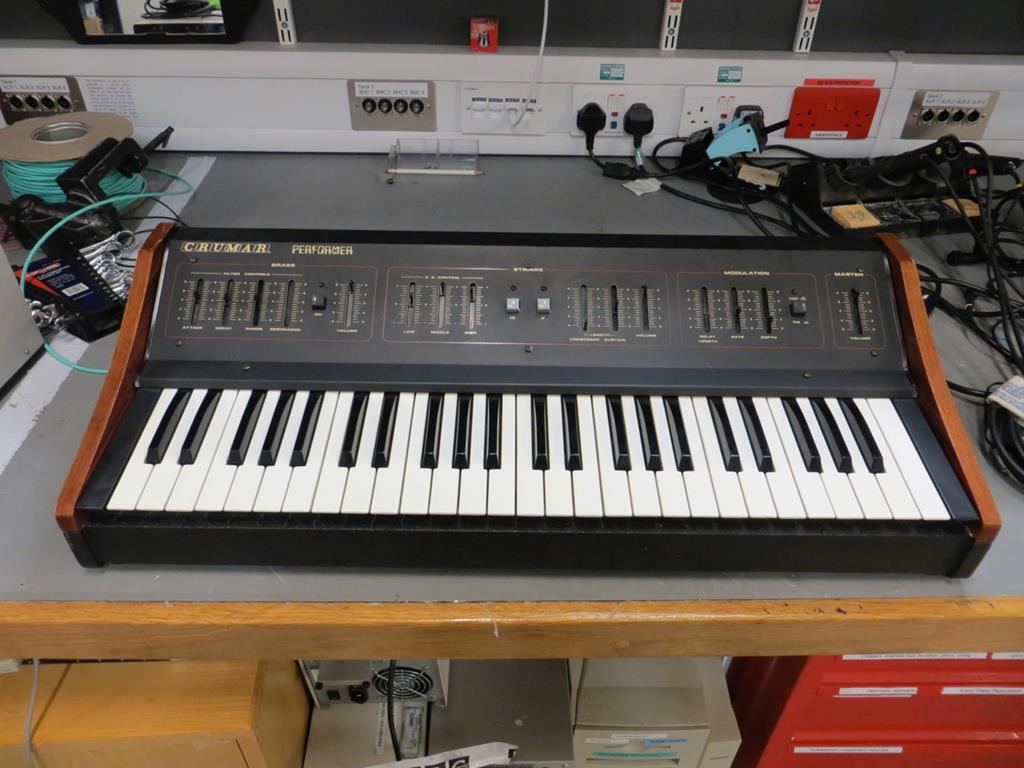
It’s a heavy little monster.
It seems many synths of the day were huge, modular things that you had to plug up. If you took them gigging you’d still be setting it up as the rest of the band were finishing the set. The Performer was a simple little thing that you took on the road and just played. It has a brass sound and two string sounds which you can twiddle with but that’s it. It’s polyphonic and you can play the brass and both string sounds at the same time if you wish.
So I plugged it in. Lights came on. That’s a good start.
Find a speaker and have a listen. Nothing. Clearly it being monophonic was an over estimate of its current capabilities.
Let’s open it up then.
When I undid one of the top panel screws the bracket clattered into the bottom of the machine. Later I found the screws floating about in there and put it back together.
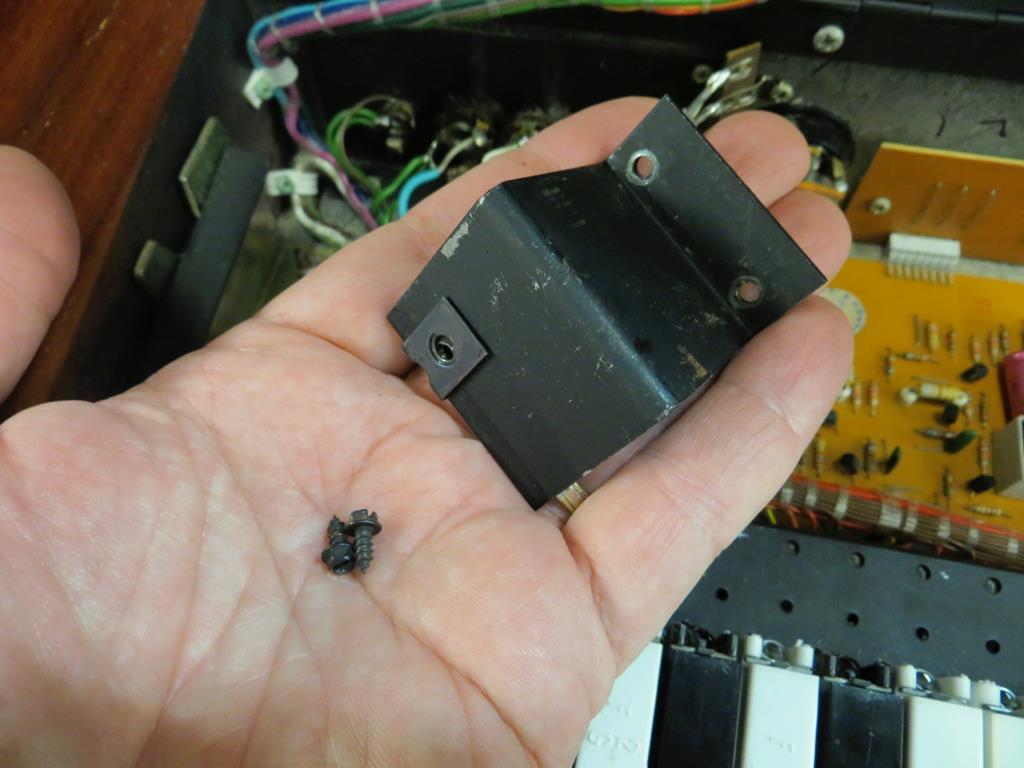
Crumar were Italian so the fact that it’s falling apart and has dodgy electronics shouldn’t come as a big surprise.
All good engineers start with the power supply so that’s what I did. Especially as it’s a separate board and right under my nose. Or, to be more accurate, right under the keyboard.
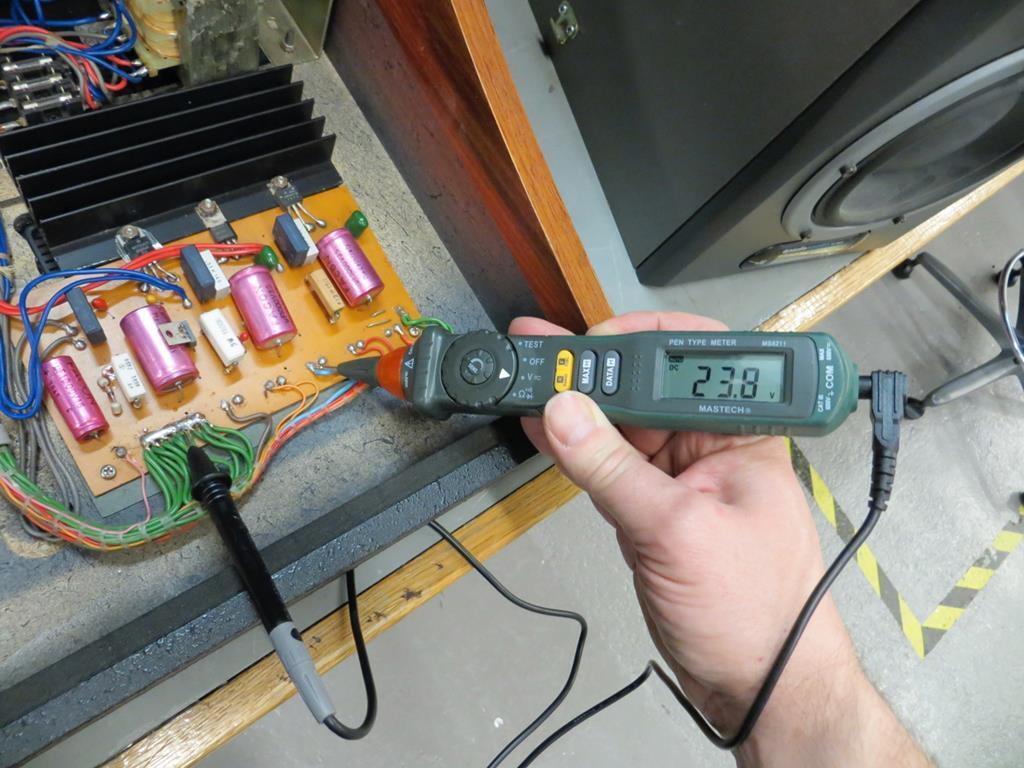
All the positive rails are there but the -24V and -12V are both missing. The circuit shows that the -12V rail is fed off the -24V rail so the lack of -24V is likely to be the root of the problem.

It’s the -24V regulator then. Yay. An easy fix!
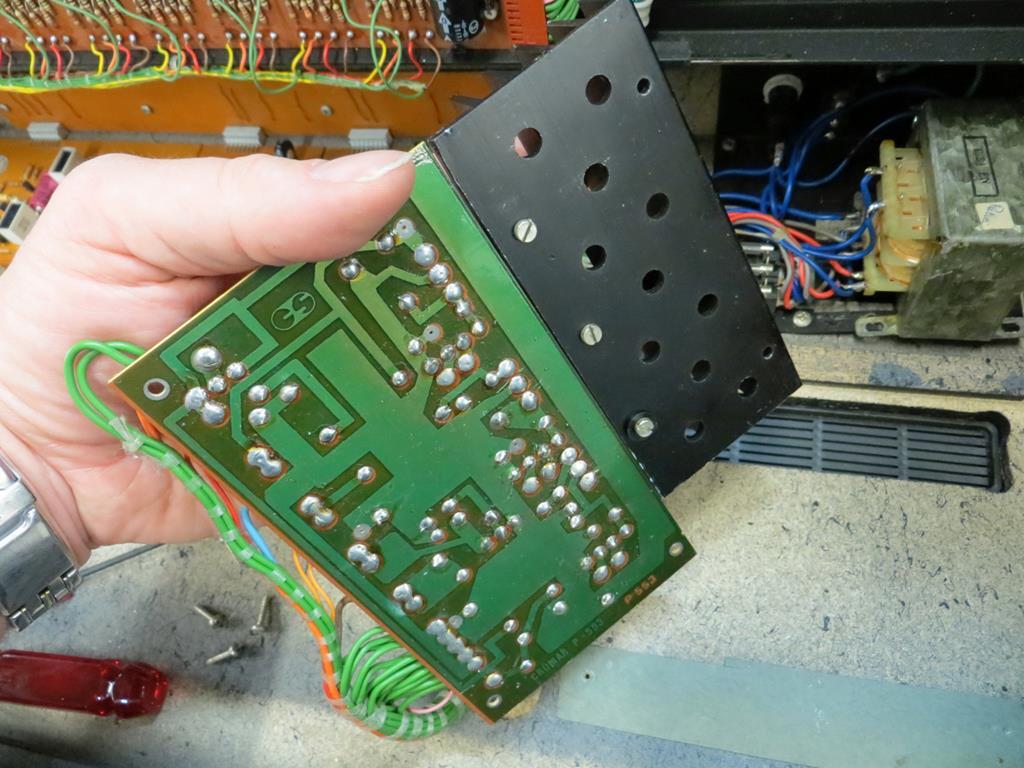
Nope. I changed the regulator and it still didn’t work. Hmmph. There must be a short circuit on the -24V rail but that could be anywhere in the synth.

And if the short’s not in that bit it could be under the keyboard…
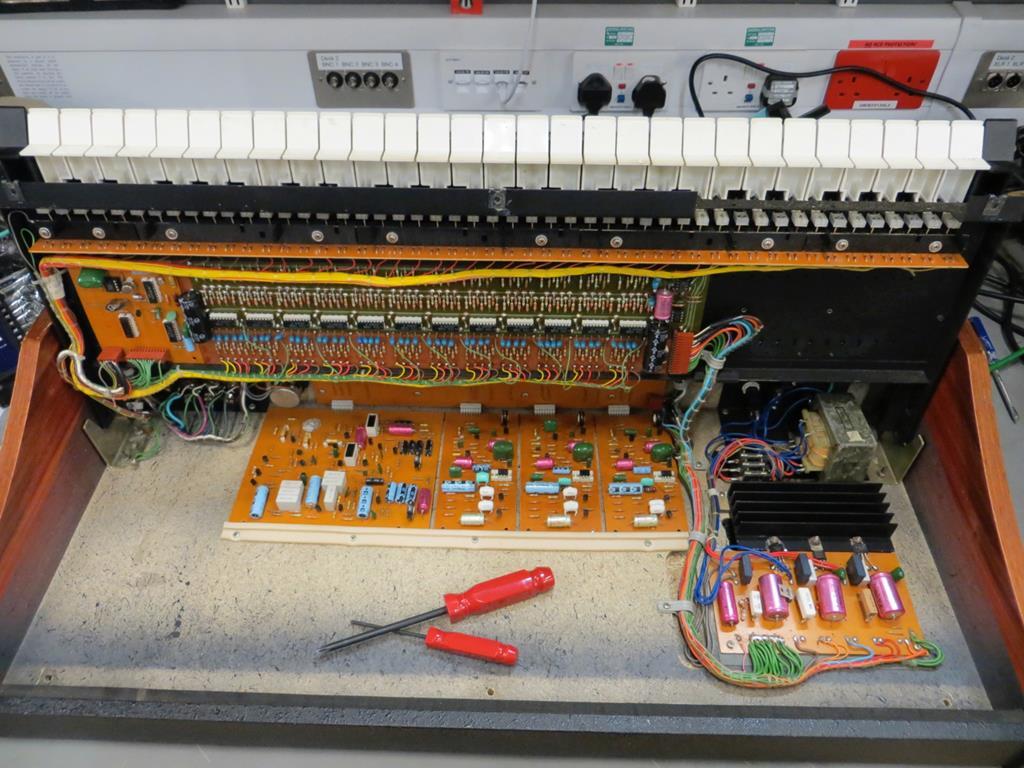
So I disconnected the output wires from the PSU with the intention of powering each board individually until I found where the fault was. The PSU was still dead with the rest of the synth disconnected! The short circuit must be in the PSU itself then.
It’s got some little bead capacitor thingies in there. They used to go short circuit in the old days. And this was built in the old days. Replace C3 then. Yay! Now I’ve got volts. Hook up the rest of the boards and listen to the magic of Duran Duran.
Er. No. It’s still as quiet as a church mouse. Arguably that’s better than most Duran records… (I wasn’t a massive fan to be honest although they are growing on me after 30 years.)
Right, so this thing has a master oscillator, running at some frequency, which feeds a master divider (known as the Top Octave Synthesiser). Out of this you get 12 frequencies that are, in effect, one octave of the keyboard.
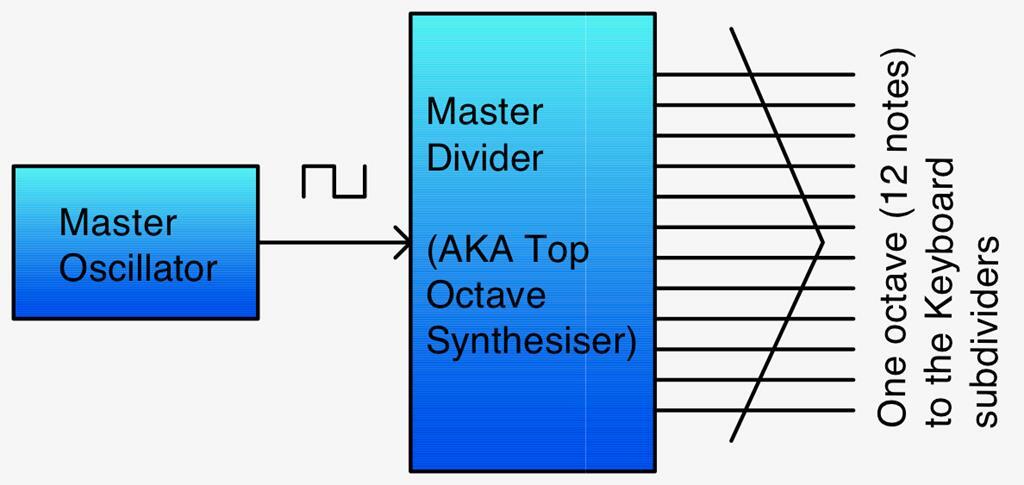
Yes, I know “octave” is 8 not 12 but there are some black keys on the keyboard too. Not sure what you use them for. From this you can tell that I can’t play a piano. Or anything else for that matter.
Starting at the beginning I can see the output of the master oscillator where it goes into the master divider. So the master oscillator is running.
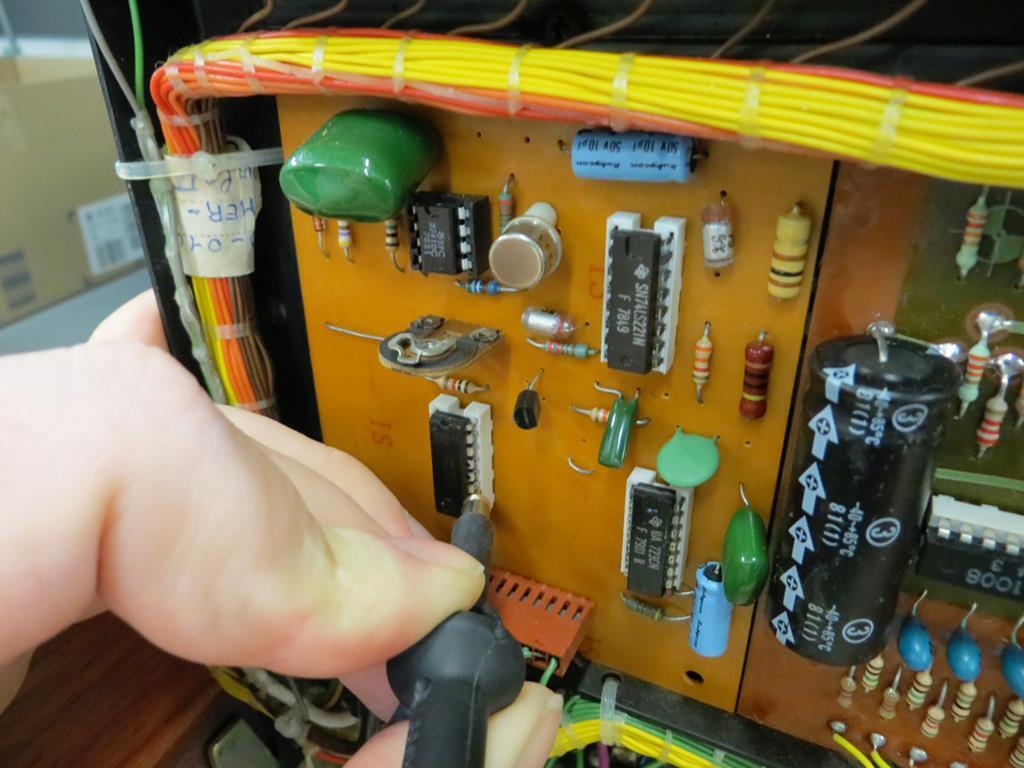
And the outputs of the master divider are all there too. This is a relief as it’s one big chip that I doubt has been made for 20 years. (A MOSTEK 50240)
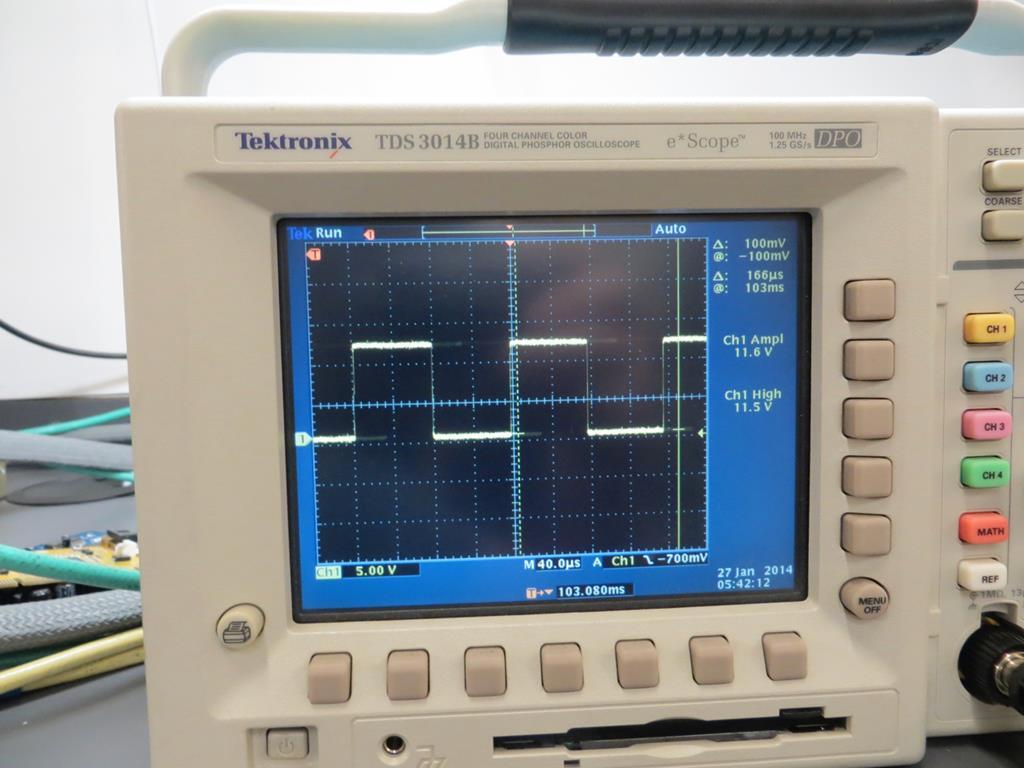
(Yes it’s a square wave.)
Each output from the master divider is then sub divided again. This effectively frequency shifts the octave and repeats it down the keyboard.
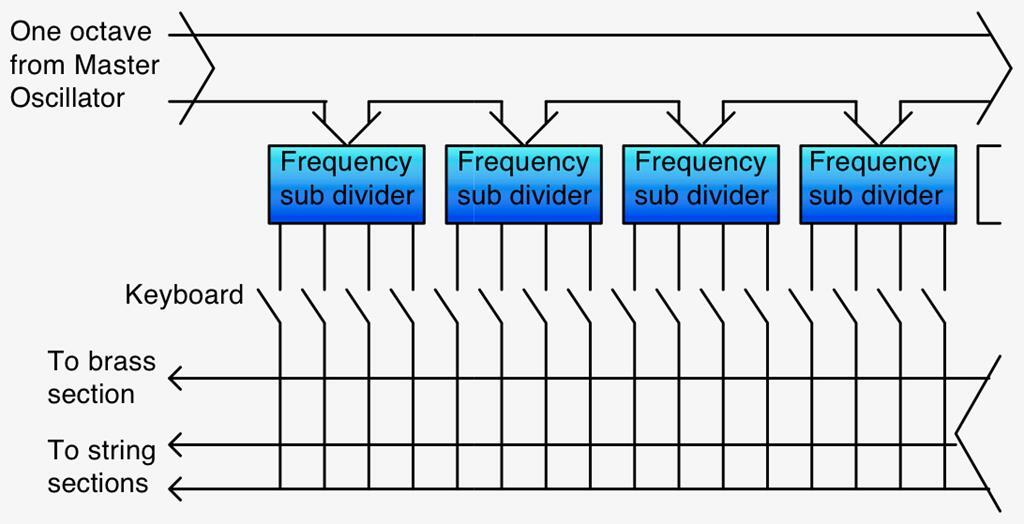
The outputs of the sub dividers (Or “notes” as we prefer to call them) are turned on by pressing the keys on the keyboard. No big shock there. The sounds from each note are then mixed into three slightly different streams of sounds. That all happens on a big circuit board across the back of the keyboard.
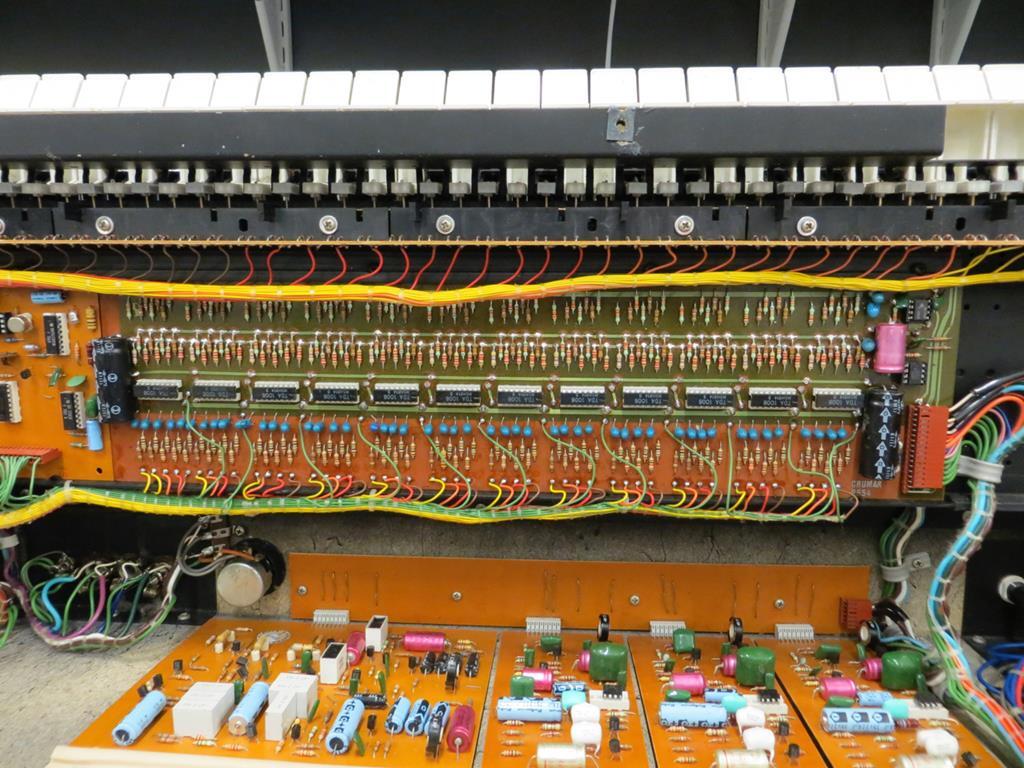
One stream of sound becomes the brass sound and the other two become the string sounds.
They dribble out of the end of the keyboard from three amplifiers.
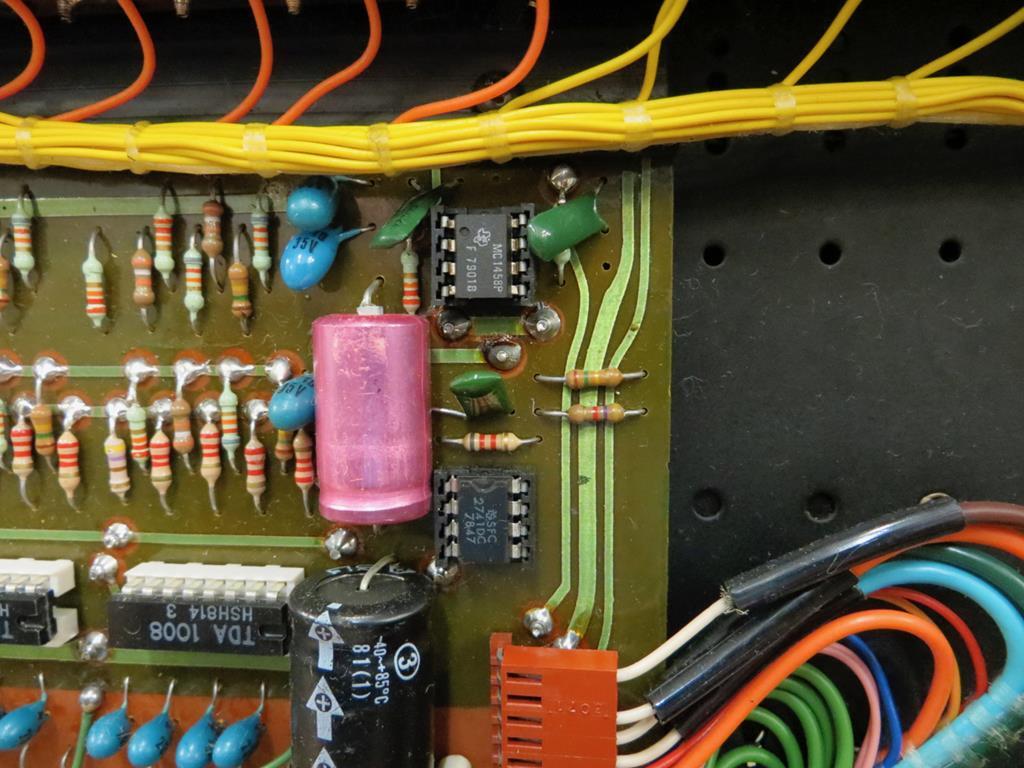
And they are all working!
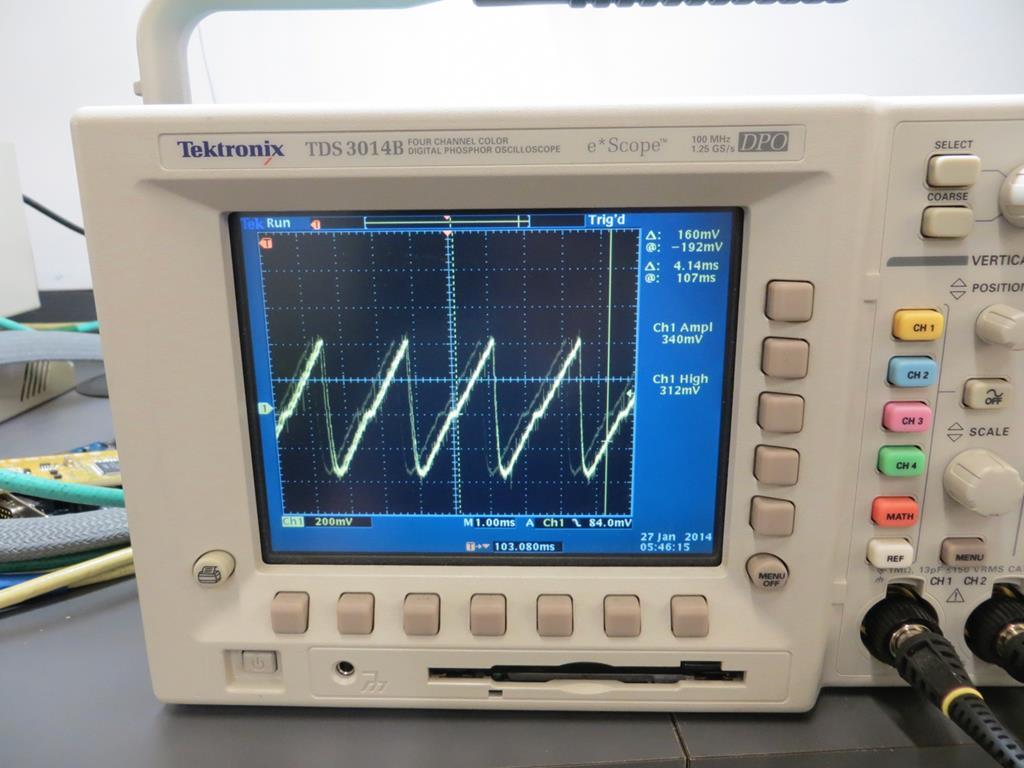
Yippee! The waveform is a different shape now because the keyboard does some clever stuff.
Not only can I see the signal but if I connect my speaker here I can hear it too. Every note on the keyboard actually works. (Another relief as those sub divider chips are probably unobtainable too.) Fantastic. Sounds like a horrible cheap crappy keyboard but at least it works. Still nothing from the main output though.
So I gave up for a while.
As it happens I had to work on Christmas day this year. It was quiet so maybe a little look at the Crumar Performer…
The three outputs from the back of the keyboard go off for some further processing. The brass output gets filtered to make it more brassy. The strings outputs also get filtered and then go off through some delay circuits.
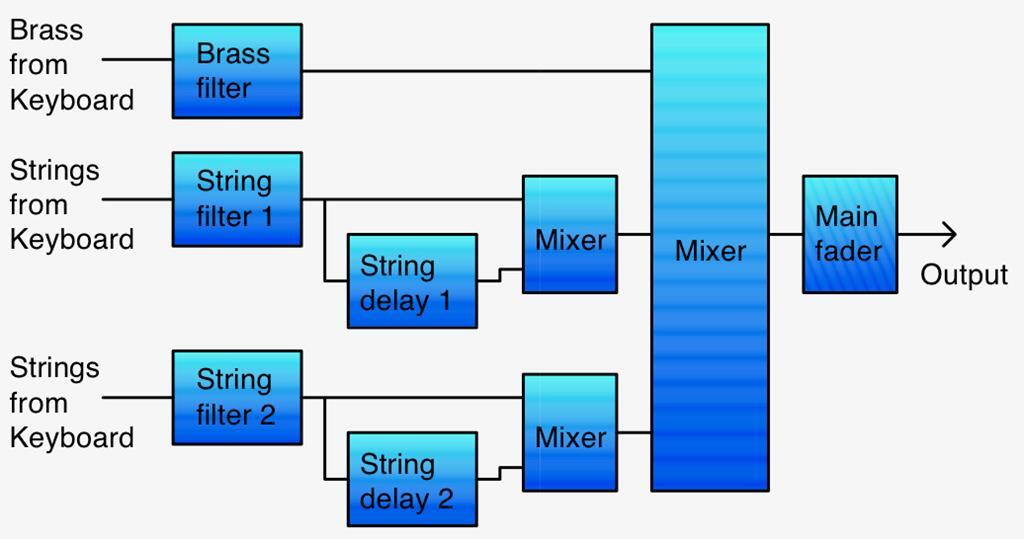
The filtering is done on this board…
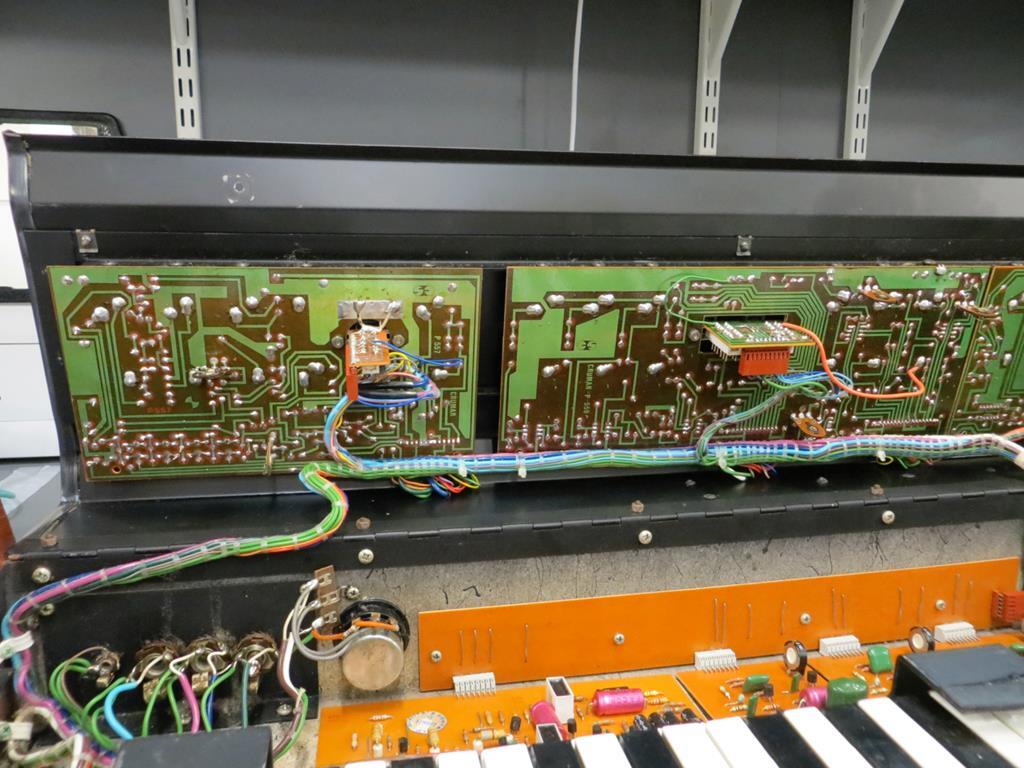
…On the back of the front panel. That’s not so easy to get to. (I need to poke around the component side rather than the back side.)
The strings delay circuits are in the bottom of the case and much more accessible.
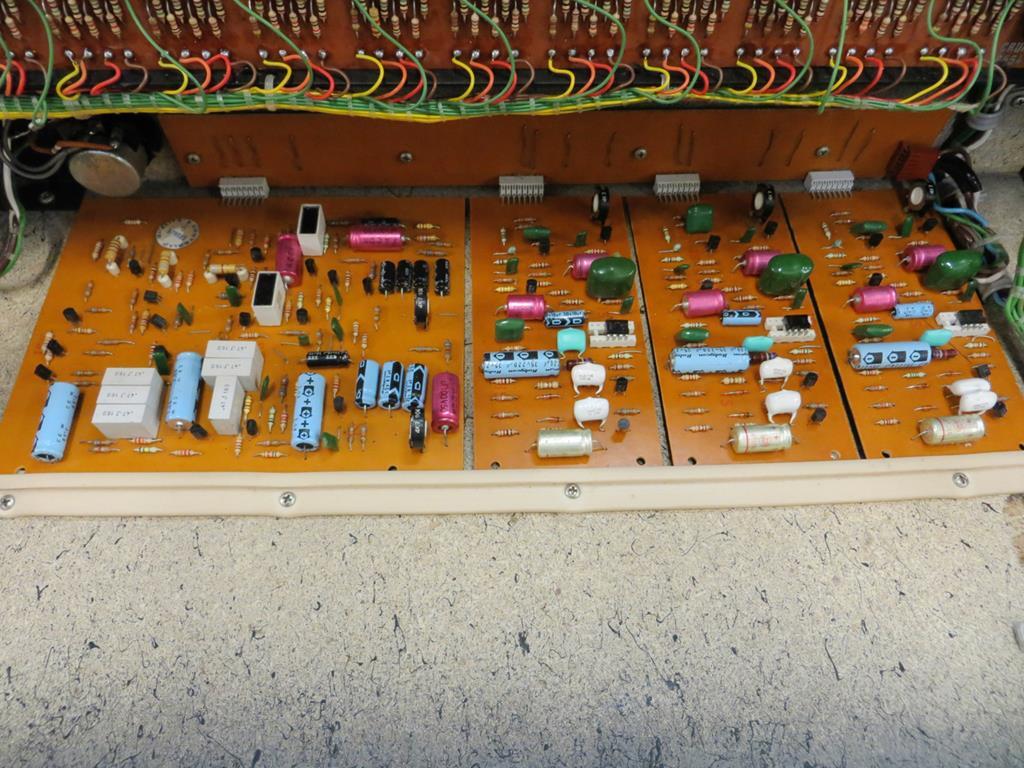
So I had a look with the scope and found a nice signal going in and a smaller one coming out. Should it be smaller? Who can say. But it’s easy enough to make a loop through plug that took the delay lines out of circuit.

Still no sound at the output but at least I can ignore the complex delay lines for the time being.
The only thing common to the brass and strings section now is the main output amp and volume control. Squirt a bit of cleaner in the volume control…
Oh yes! It’s finally alive! But all the controls need cleaning. Bite the bullet and take the filter board off for a proper cleaning session.
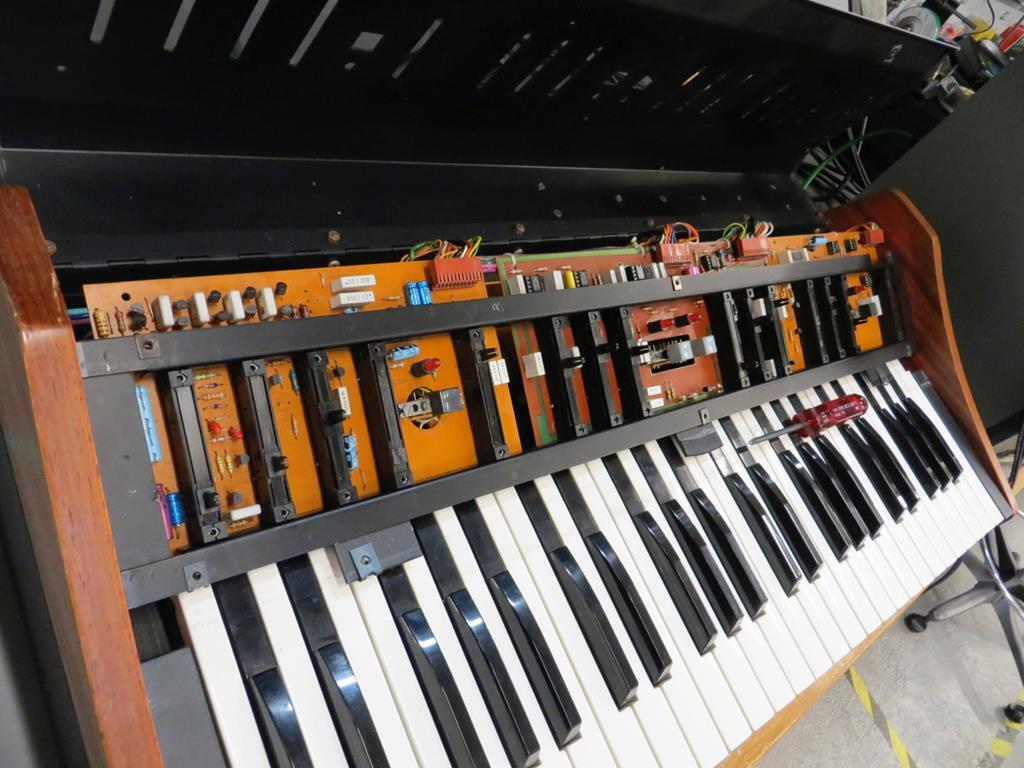
I had a look to see if I could replace all the sliders, especially as two were broken already. But they are such odd shapes and values I don’t think it’s possible. Not easily anyway. Cleaning will have to do.
The brass sounds great now. I think the filters are set to resonate a little at the start of a note so you get a little brass like “parp” sound at the beginning of the note. It’s lovely.
The strings are flat and horrid though. Oh, but I need to plug in the delay lines again.
They add a lot of depth to the sound. They probably go some way to simulating the reverberation in the body of a real string instrument.
One last job… The mains transformer is falling out.
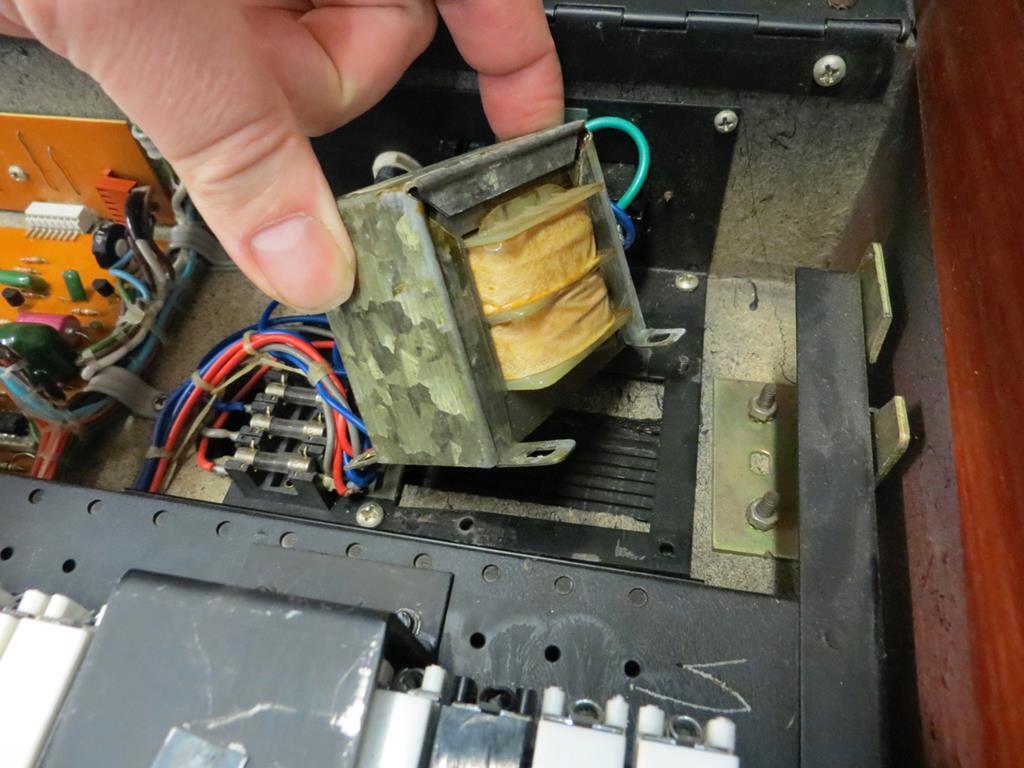
Probably should have opened it up and fixed that before I plugged it in… It’s properly bolted in now.
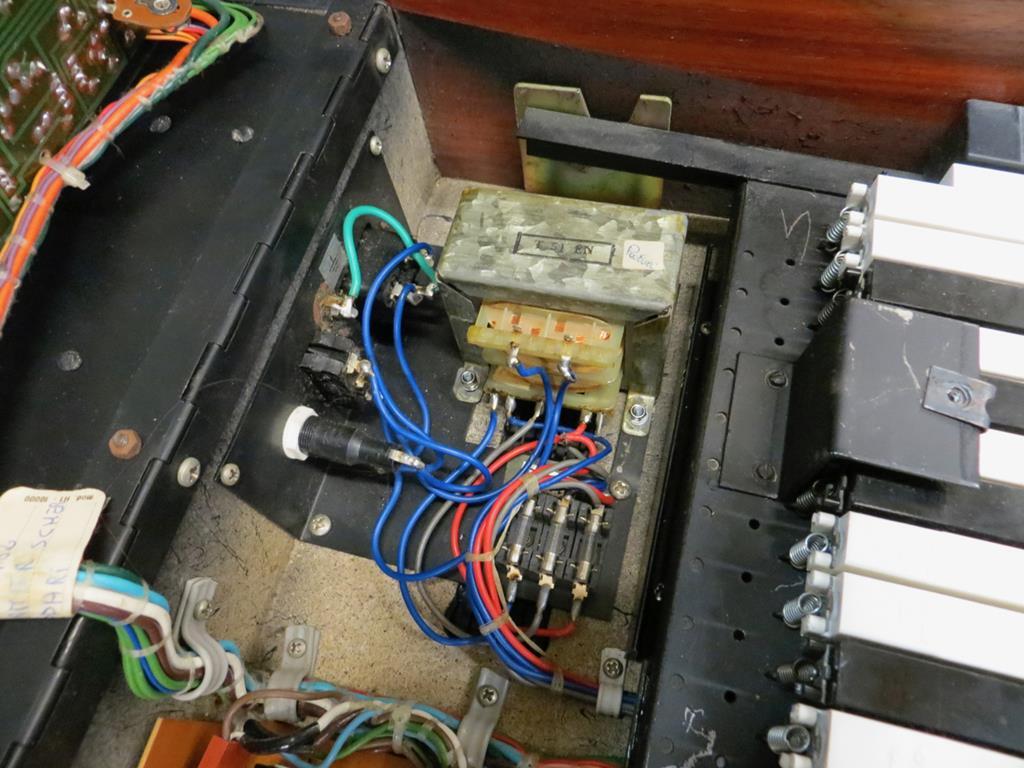
So that’s about it. Working again and I’ve had the pleasure of hearing it come back to life.
It can sound a bit Dr Who / Radiophonic Workshop if you want it to (I’m not very fond of that) or it can sound very natural and sweet.
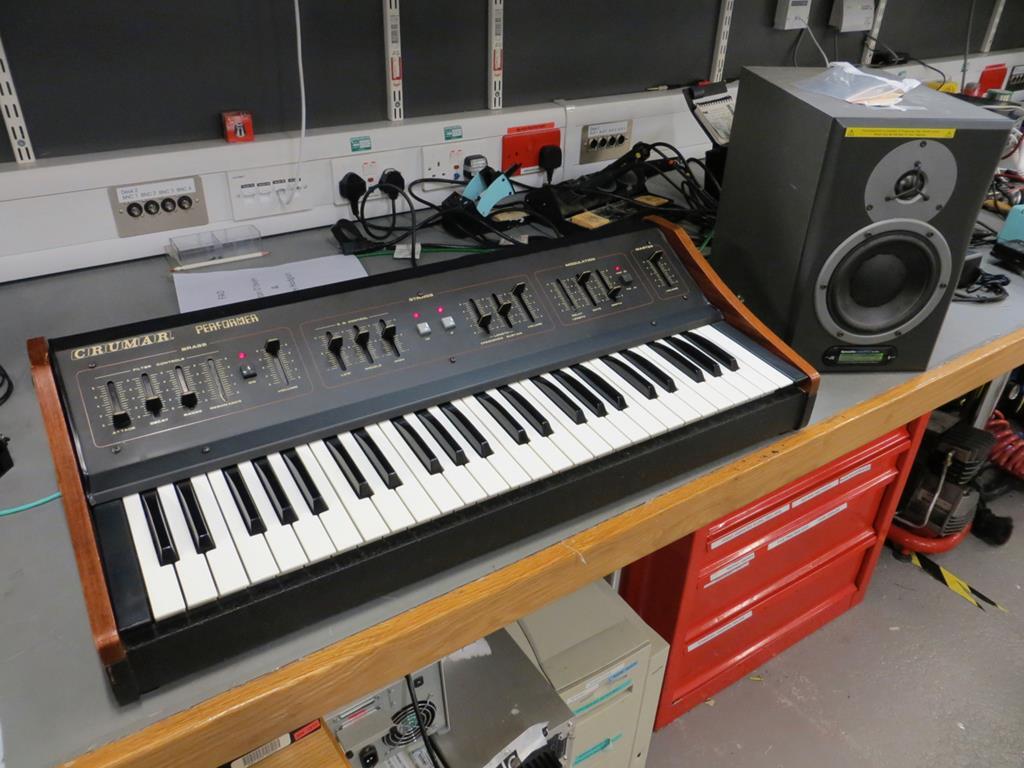
You are never going to believe a trumpet and string quartet have struck up in your front room but it’s wonderful reminder of those classic synth string sounds from 80s pop and prog rock.
With a bit of fiddling I got the edgy parp from the brass section then the strings gently came in and filled out the sound if you held the note. Very lovely indeed.
I’d never heard of a Crumar Performer a few weeks ago. Now I rather like it. In fact I’ve grown to be very fond of it and I’m going to miss it when its owner picks it up.
I just wish I’d learned to play a keyboard when I was young so I could really enjoy this one while it’s still in the workshop.
Not very "cars" but very "retro" so I hope you'll forgive me for posting. And thanks for reading.
If you have questions about the electronics and how it works please ask and I'll try and explain further. I know I've glossed over a lot of it 'cos I didn't want to bore you all to tears.
James
I think he was expecting me to say “Duran who?” but obviously I’ve heard of them. Surely people who haven’t heard of them could be counted on the fingers of one foot.
"Er, yes. Haven't you?"
"Well, yes" he said but didn’t sound sure.
Bob is a colleague of mine at work. He’s younger than me and was brought up by nuns in a convent in Ireland. At least this is what I assume since he seems unclear about the existence of a major 80's pop group. As it happens my missus was a bit of a Duran fan back in the day and fancied one of the band. The ugly one as far as I can tell. I don't know what says about me.
"Why do you ask?"
"Well..." starts Bob, "...my mate has an old analogue synthesiser from the late 70s or early 80s. And it's the same type that Duran Duran used on some of their early records."
"Ok, right..."
"It's a Crumar Performer."
"A what?"
"Crumar Performer. There is a chap from a Duran Duran tribute band who might buy it but it doesn't work. Wondered if you might like to take a look.
Ah. Now I understand. A 35 year old pile of tat that need fixing. What are my chances given that I know nothing about ancient synths and have no circuit diagrams. I’m just not interested.
“I’ll email you the circuit diagrams.”
“Ok. What’s wrong with it?” Damn. He’s getting me interested.
“Apparently it’s gone monophonic.”
“It can’t have.” I said, looking over the circuits. “It can’t possibly have gone monophonic. It just can’t…”
Many old synths could only play one note at a time (monophonic). This one could play several at a time (polyphonic). In fact it should be able to play all the notes at the same time if you could grow enough fingers to press all the keys.
“You know there is little chance of me getting it going. And I’ve got work to do.... Oh bring it in and I’ll take a quick look if I get a moment.”
 ! Now I’m interested and this could very well turn into a total nightmare.
! Now I’m interested and this could very well turn into a total nightmare.So just before Christmas the Crumar Performer arrived at work.

It’s a heavy little monster.
It seems many synths of the day were huge, modular things that you had to plug up. If you took them gigging you’d still be setting it up as the rest of the band were finishing the set. The Performer was a simple little thing that you took on the road and just played. It has a brass sound and two string sounds which you can twiddle with but that’s it. It’s polyphonic and you can play the brass and both string sounds at the same time if you wish.
So I plugged it in. Lights came on. That’s a good start.
Find a speaker and have a listen. Nothing. Clearly it being monophonic was an over estimate of its current capabilities.
Let’s open it up then.
When I undid one of the top panel screws the bracket clattered into the bottom of the machine. Later I found the screws floating about in there and put it back together.

Crumar were Italian so the fact that it’s falling apart and has dodgy electronics shouldn’t come as a big surprise.
All good engineers start with the power supply so that’s what I did. Especially as it’s a separate board and right under my nose. Or, to be more accurate, right under the keyboard.

All the positive rails are there but the -24V and -12V are both missing. The circuit shows that the -12V rail is fed off the -24V rail so the lack of -24V is likely to be the root of the problem.

It’s the -24V regulator then. Yay. An easy fix!

Nope. I changed the regulator and it still didn’t work. Hmmph. There must be a short circuit on the -24V rail but that could be anywhere in the synth.

And if the short’s not in that bit it could be under the keyboard…

So I disconnected the output wires from the PSU with the intention of powering each board individually until I found where the fault was. The PSU was still dead with the rest of the synth disconnected! The short circuit must be in the PSU itself then.
It’s got some little bead capacitor thingies in there. They used to go short circuit in the old days. And this was built in the old days. Replace C3 then. Yay! Now I’ve got volts. Hook up the rest of the boards and listen to the magic of Duran Duran.
Er. No. It’s still as quiet as a church mouse. Arguably that’s better than most Duran records… (I wasn’t a massive fan to be honest although they are growing on me after 30 years.)
Right, so this thing has a master oscillator, running at some frequency, which feeds a master divider (known as the Top Octave Synthesiser). Out of this you get 12 frequencies that are, in effect, one octave of the keyboard.

Yes, I know “octave” is 8 not 12 but there are some black keys on the keyboard too. Not sure what you use them for. From this you can tell that I can’t play a piano. Or anything else for that matter.
Starting at the beginning I can see the output of the master oscillator where it goes into the master divider. So the master oscillator is running.

And the outputs of the master divider are all there too. This is a relief as it’s one big chip that I doubt has been made for 20 years. (A MOSTEK 50240)

(Yes it’s a square wave.)
Each output from the master divider is then sub divided again. This effectively frequency shifts the octave and repeats it down the keyboard.

The outputs of the sub dividers (Or “notes” as we prefer to call them) are turned on by pressing the keys on the keyboard. No big shock there. The sounds from each note are then mixed into three slightly different streams of sounds. That all happens on a big circuit board across the back of the keyboard.

One stream of sound becomes the brass sound and the other two become the string sounds.
They dribble out of the end of the keyboard from three amplifiers.

And they are all working!

Yippee! The waveform is a different shape now because the keyboard does some clever stuff.
Not only can I see the signal but if I connect my speaker here I can hear it too. Every note on the keyboard actually works. (Another relief as those sub divider chips are probably unobtainable too.) Fantastic. Sounds like a horrible cheap crappy keyboard but at least it works. Still nothing from the main output though.
So I gave up for a while.
As it happens I had to work on Christmas day this year. It was quiet so maybe a little look at the Crumar Performer…
The three outputs from the back of the keyboard go off for some further processing. The brass output gets filtered to make it more brassy. The strings outputs also get filtered and then go off through some delay circuits.

The filtering is done on this board…

…On the back of the front panel. That’s not so easy to get to. (I need to poke around the component side rather than the back side.)
The strings delay circuits are in the bottom of the case and much more accessible.

So I had a look with the scope and found a nice signal going in and a smaller one coming out. Should it be smaller? Who can say. But it’s easy enough to make a loop through plug that took the delay lines out of circuit.

Still no sound at the output but at least I can ignore the complex delay lines for the time being.
The only thing common to the brass and strings section now is the main output amp and volume control. Squirt a bit of cleaner in the volume control…
Oh yes! It’s finally alive! But all the controls need cleaning. Bite the bullet and take the filter board off for a proper cleaning session.

I had a look to see if I could replace all the sliders, especially as two were broken already. But they are such odd shapes and values I don’t think it’s possible. Not easily anyway. Cleaning will have to do.
The brass sounds great now. I think the filters are set to resonate a little at the start of a note so you get a little brass like “parp” sound at the beginning of the note. It’s lovely.
The strings are flat and horrid though. Oh, but I need to plug in the delay lines again.
They add a lot of depth to the sound. They probably go some way to simulating the reverberation in the body of a real string instrument.
One last job… The mains transformer is falling out.

Probably should have opened it up and fixed that before I plugged it in… It’s properly bolted in now.

So that’s about it. Working again and I’ve had the pleasure of hearing it come back to life.
It can sound a bit Dr Who / Radiophonic Workshop if you want it to (I’m not very fond of that) or it can sound very natural and sweet.

You are never going to believe a trumpet and string quartet have struck up in your front room but it’s wonderful reminder of those classic synth string sounds from 80s pop and prog rock.
With a bit of fiddling I got the edgy parp from the brass section then the strings gently came in and filled out the sound if you held the note. Very lovely indeed.
I’d never heard of a Crumar Performer a few weeks ago. Now I rather like it. In fact I’ve grown to be very fond of it and I’m going to miss it when its owner picks it up.
I just wish I’d learned to play a keyboard when I was young so I could really enjoy this one while it’s still in the workshop.
Not very "cars" but very "retro" so I hope you'll forgive me for posting. And thanks for reading.
If you have questions about the electronics and how it works please ask and I'll try and explain further. I know I've glossed over a lot of it 'cos I didn't want to bore you all to tears.
James









